Plant Population Classification Based on PointCNN in the Daliyabuyi Oasis, China
Abstract
1. Introduction
2. Materials and Methods
2.1. Study Area
2.2. Data
2.3. Methods
2.3.1. Decorrelation Stretching
2.3.2. PointCNN
2.4. PointCNN Dataset Construction
3. Results and Analysis
3.1. Decorrelation Stretching Results
3.2. PointCNN Classification Results
3.3. Extraction of Individual Tree Information for Populus euphratica
3.4. Comparison with Two-Dimensional Deep Learning
4. Discussion
5. Conclusions
Author Contributions
Funding
Data Availability Statement
Acknowledgments
Conflicts of Interest
References
- Bezerra, F.G.S.; Aguiar, A.P.D.; Alvalá, R.C.S.; Giarolla, A.; Bezerra, K.R.A.; Lima, P.V.P.S.; Do Nascimento, F.R.; Arai, E. Analysis of Areas Undergoing Desertification, Using EVI2 Multi-Temporal Data Based on MODIS Imagery as Indicator. Ecol. Indic. 2020, 117, 106579. [Google Scholar] [CrossRef]
- Ma, X.; Zhu, J.; Yan, W.; Zhao, C. Projections of Desertification Trends in Central Asia under Global Warming Scenarios. Sci. Total Environ. 2021, 781, 146777. [Google Scholar] [CrossRef] [PubMed]
- Aishan, T.; Halik, Ü.; Betz, F.; Gärtner, P.; Cyffka, B. Modeling Height–Diameter Relationship for Populus euphratica in the Tarim Riparian Forest Ecosystem, Northwest China. J. For. Res. 2016, 27, 889–900. [Google Scholar] [CrossRef]
- Xiao, F.; Li, Y.; Li, G.; He, Y.; Lv, X.; Zhuang, L.; Pu, X. High throughput sequencing-based analysis of the soil bacterial community structure and functions of Tamarix shrubs in the lower reaches of the Tarim River. PeerJ 2021, 9, e12105. [Google Scholar] [CrossRef]
- Bencherif, K.; Trodi, F.; Hamidi, M.; Dalpè, Y.; Hadj-Sahraoui, A.L. Biological overview and adaptability strategies of Tamarix plants, T. articulata and T. gallica to abiotic Stress. Plant Stress Biol. Strateg. Trends 2020, 401–433. [Google Scholar] [CrossRef]
- Chen, Y.; Chen, Y.; Xu, C.; Li, W. The Effects of Groundwater Depth on Water Uptake of Populus Euphratica and Tamarix Ramosissima in the Hyperarid Region of Northwestern China. Environ. Sci. Pollut. Res. 2016, 23, 17404–17412. [Google Scholar] [CrossRef] [PubMed]
- Li, D.; Si, J.; Zhang, X.; Gao, Y.; Luo, H.; Qin, J.; Gao, G. Comparison of Branch Water Relations in Two Riparian Species: Populus Euphratica and Tamarix Ramosissima. Sustainability 2019, 11, 5461. [Google Scholar] [CrossRef]
- Zhang, T.; Chen, Y.; Ali, S. Abiotic Stress and Human Activities Reduce Plant Diversity in Desert Riparian Forests. Ecol. Indic. 2023, 152, 110340. [Google Scholar] [CrossRef]
- Lang, P.; Jeschke, M.; Wommelsdorf, T.; Backes, T.; Lv, C.; Zhang, X.; Thomas, F.M. Wood Harvest by Pollarding Exerts Long-Term Effects on Populus Euphratica Stands in Riparian Forests at the Tarim River, NW China. For. Ecol. Manag. 2015, 353, 87–96. [Google Scholar] [CrossRef]
- Venter, Z.S.; Scott, S.L.; Desmet, P.G.; Hoffman, M.T. Application of Landsat-Derived Vegetation Trends over South Africa: Potential for Monitoring Land Degradation and Restoration. Ecol. Indic. 2020, 113, 106206. [Google Scholar] [CrossRef]
- Li, H.; Shi, Q.; Wan, Y.; Shi, H.; Imin, B. Influence of Surface Water on Desert Vegetation Expansion at the Landscape Scale: A Case Study of the Daliyabuyi Oasis, Taklamakan Desert. Sustainability 2021, 13, 9522. [Google Scholar] [CrossRef]
- Buffi, G.; Manciola, P.; Grassi, S.; Barberini, M.; Gambi, A. Survey of the Ridracoli Dam: UAV–Based Photogrammetry and Traditional Topographic Techniques in the Inspection of Vertical Structures. Geomat. Nat. Hazards Risk 2017, 8, 1562–1579. [Google Scholar] [CrossRef]
- Ruppert, K.M.; Kline, R.J.; Rahman, M.S. Past, Present, and Future Perspectives of Environmental DNA (EDNA) Metabarcoding: A Systematic Review in Methods, Monitoring, and Applications of Global EDNA. Glob. Ecol. Conserv. 2019, 17, e00547. [Google Scholar] [CrossRef]
- Lee, S.; Xiao, C.; Pei, S. Ethnobotanical Survey of Medicinal Plants at Periodic Markets of Honghe Prefecture in Yunnan Province, SW China. J. Ethnopharmacol. 2008, 117, 362–377. [Google Scholar] [CrossRef]
- Xiao, Q.; Ustin, S.L.; McPherson, E.G. Using AVIRIS data and multiple-masking techniques to map urban forest tree species. Int. J. Remote Sens. 2004, 25, 5637–5654. [Google Scholar] [CrossRef]
- Ayhan, B.; Kwan, C.; Budavari, B.; Kwan, L.; Lu, Y.; Perez, D.; Li, J.; Skarlatos, D.; Vlachos, M. Vegetation Detection Using Deep Learning and Conventional Methods. Remote Sens. 2020, 12, 2502. [Google Scholar] [CrossRef]
- Fawcett, D.; Panigada, C.; Tagliabue, G.; Boschetti, M.; Celesti, M.; Evdokimov, A.; Biriukova, K.; Colombo, R.; Miglietta, F.; Rascher, U.; et al. Multi-Scale Evaluation of Drone-Based Multispectral Surface Reflectance and Vegetation Indices in Operational Conditions. Remote Sens. 2020, 12, 514. [Google Scholar] [CrossRef]
- Manfreda, S.; McCabe, M.F.; Miller, P.E.; Lucas, R.; Pajuelo Madrigal, V.; Mallinis, G.; Ben Dor, E.; Helman, D.; Estes, L.; Ciraolo, G.; et al. On the use of unmanned aerial systems for environmental monitoring. Remote Sens. 2018, 10, 641. [Google Scholar] [CrossRef]
- Immitzer, M.; Atzberger, C.; Koukal, T. Tree Species Classification with Random Forest Using Very High Spatial Resolution 8-Band WorldView-2 Satellite Data. Remote Sens. 2012, 4, 2661–2693. [Google Scholar] [CrossRef]
- Farrell, S.L.; Collier, B.A.; Skow, K.L.; Long, A.M.; Campomizzi, A.J.; Morrison, M.L.; Hays, K.B.; Wilkins, R.N. Using LiDAR-Derived Vegetation Metrics for High-Resolution, Species Distribution Models for Conservation Planning. Ecosphere 2013, 4, art42. [Google Scholar] [CrossRef]
- Immitzer, M.; Böck, S.; Einzmann, K.; Vuolo, F.; Pinnel, N.; Wallner, A.; Atzberger, C. Fractional Cover Mapping of Spruce and Pine at 1 Ha Resolution Combining Very High and Medium Spatial Resolution Satellite Imagery. Remote Sens. Environ. 2018, 204, 690–703. [Google Scholar] [CrossRef]
- Kaartinen, H.; Hyyppä, J.; Yu, X.; Vastaranta, M.; Hyyppä, H.; Kukko, A.; Holopainen, M.; Heipke, C.; Hirschmugl, M.; Morsdorf, F.; et al. An International Comparison of Individual Tree Detection and Extraction Using Airborne Laser Scanning. Remote Sens. 2012, 4, 950–974. [Google Scholar] [CrossRef]
- Vescovo, L.; Wohlfahrt, G.; Balzarolo, M.; Pilloni, S.; Sottocornola, M.; Rodeghiero, M.; Gianelle, D. New Spectral Vegetation Indices Based on the Near-Infrared Shoulder Wavelengths for Remote Detection of Grassland Phytomass. Int. J. Remote Sens. 2012, 33, 2178–2195. [Google Scholar] [CrossRef] [PubMed]
- Ji, W.; Wang, L. Phenology-Guided Saltcedar (Tamarix Spp.) Mapping Using Landsat TM Images in Western U.S. Remote Sens. Environ. 2016, 173, 29–38. [Google Scholar] [CrossRef]
- Diao, C.; Wang, L. Incorporating Plant Phenological Trajectory in Exotic Saltcedar Detection with Monthly Time Series of Landsat Imagery. Remote Sens. Environ. 2016, 182, 60–71. [Google Scholar] [CrossRef]
- Gandhi, G.M.; Parthiban, S.; Thummalu, N.; Christy, A. Ndvi: Vegetation Change Detection Using Remote Sensing and Gis—A Case Study of Vellore District. Procedia Comput. Sci. 2015, 57, 1199–1210. [Google Scholar] [CrossRef]
- Zhou, L.; Lyu, A. Investigating Natural Drivers of Vegetation Coverage Variation Using MODIS Imagery in Qinghai, China. J. Arid Land 2016, 8, 109–124. [Google Scholar] [CrossRef][Green Version]
- Næsset, E.; Nelson, R. Using Airborne Laser Scanning to Monitor Tree Migration in the Boreal–Alpine Transition Zone. Remote Sens. Environ. 2007, 110, 357–369. [Google Scholar] [CrossRef]
- Dash, J.P.; Watt, M.S.; Paul, T.S.H.; Morgenroth, J.; Hartley, R. Taking a Closer Look at Invasive Alien Plant Research: A Review of the Current State, Opportunities, and Future Directions for UAVs. Methods Ecol. Evol. 2019, 10, 2020–2033. [Google Scholar] [CrossRef]
- Goodbody, T.R.H.; Coops, N.C.; Hermosilla, T.; Tompalski, P.; Crawford, P. Assessing the Status of Forest Regeneration Using Digital Aerial Photogrammetry and Unmanned Aerial Systems. Int. J. Remote Sens. 2018, 39, 5246–5264. [Google Scholar] [CrossRef]
- Roy, K.; Chaudhuri, S.S.; Pramanik, S. Deep Learning Based Real-Time Industrial Framework for Rotten and Fresh Fruit Detection Using Semantic Segmentation. Microsyst. Technol. 2021, 27, 3365–3375. [Google Scholar] [CrossRef]
- Kim, W.-S.; Lee, D.-H.; Kim, T.; Kim, H.; Sim, T.; Kim, Y.-J. Weakly Supervised Crop Area Segmentation for an Autonomous Combine Harvester. Sensors 2021, 21, 4801. [Google Scholar] [CrossRef]
- Wu, H.; Liang, C.; Liu, M.; Wen, Z. Optimized HRNet for Image Semantic Segmentation. Expert Syst. Appl. 2021, 174, 114532. [Google Scholar] [CrossRef]
- Zhang, Y.; Lu, Z.; Zhang, X.; Xue, J.-H.; Liao, Q. Deep Learning in Lane Marking Detection: A Survey. IEEE Trans. Intell. Transport. Syst. 2022, 23, 5976–5992. [Google Scholar] [CrossRef]
- Zhang, M.; Li, Z.; Wu, X. Semantic segmentation method accelerated quantitative analysis of the spatial characteristics of traditional villages. Int. Arch. Photogramm. Remote Sens. Spatial Inf. Sci. 2021, 46, 933–939. [Google Scholar] [CrossRef]
- Fareed, N.; Flores, J.P.; Das, A.K. Analysis of UAS-LiDAR Ground Points Classification in Agricultural Fields Using Traditional Algorithms and PointCNN. Remote Sens. 2023, 15, 483. [Google Scholar] [CrossRef]
- Shen, X.; Huang, Q.; Wang, X.; Li, J.; Xi, B. A Deep Learning-Based Method for Extracting Standing Wood Feature Parameters from Terrestrial Laser Scanning Point Clouds of Artificially Planted Forest. Remote Sens. 2022, 14, 3842. [Google Scholar] [CrossRef]
- Jeong, S.; Otsuki, K.; Shinohara, Y.; Inoue, A.; Ichihashi, R. Stemflow Estimation Models for Japanese Cedar and Cypress Plantations Using Common Forest Inventory Data. Agric. For. Meteorol. 2020, 290, 107997. [Google Scholar] [CrossRef]
- Yang, H.; Du, J. Classification of Desert Steppe Species Based on Unmanned Aerial Vehicle Hyperspectral Remote Sensing and Continuum Removal Vegetation Indices. Optik 2021, 247, 167877. [Google Scholar] [CrossRef]
- Peng, L.; Shi, Q.-D.; Wan, Y.-B.; Shi, H.-B.; Kahaer, Y.; Abudu, A. Impact of Flooding on Shallow Groundwater Chemistry in the Taklamakan Desert Hinterland: Remote Sensing Inversion and Geochemical Methods. Water 2022, 14, 1724. [Google Scholar] [CrossRef]
- Allison, G.B.; Gee, G.W.; Tyler, S.W. Vadose-Zone Techniques for Estimating Groundwater Recharge in Arid and Semiarid Regions. Soil Sci. Soc. Am. J. 1994, 58, 6–14. [Google Scholar] [CrossRef]
- Tayir, M.; Dai, Y.; Shi, Q.; Abdureyim, A.; Erkin, F.; Huang, W. Distinct leaf functional traits of Tamarix chinensis at different habitats in the hinterland of the Taklimakan desert. Front. Plant Sci. 2023, 13, 1094049. [Google Scholar] [CrossRef] [PubMed]
- Wang, N.; Cheng, W.; Wang, B.; Liu, Q.; Zhou, C. Geomorphological Regionalization Theory System and Division Methodology of China. J. Geogr. Sci. 2020, 30, 212–232. [Google Scholar] [CrossRef]
- Ali-Bik, M.W.; Gabr, S.S.; Hassan, S.M. Spectral Characteristics, Petrography and Opaque Mineralogy of the Oligo-Miocene Basalts at Wadi Abu Qada- Wadi Wata Area, West-Central Sinai, Egypt. Egypt. J. Remote Sens. Space Sci. 2022, 25, 529–540. [Google Scholar] [CrossRef]
- Gillespie, A.R.; Kahle, A.B.; Walker, R.E. Color Enhancement of Highly Correlated Images. I. Decorrelation and HSI Contrast Stretehe. Remote Sens. Environ. 1986, 20, 209–235. [Google Scholar] [CrossRef]
- Shakya, A.K.; Ramola, A.; Vidyarthi, A.; Sawant, K. Satellite Image Enhancement for Small Particle Observation Using Decorrelation Stretcher. In Proceedings of the 2020 International Conference on Advances in Computing, Communication & Materials (ICACCM), Dehradun, India, 21–22 August 2020; IEEE: Dehradun, India, 2020; pp. 65–70. [Google Scholar]
- Rajendran, S.; Vethamony, P.; Sadooni, F.N.; Al-Kuwari, H.A.-S.; Al-Khayat, J.A.; Govil, H.; Nasir, S. Sentinel-2 Image Transformation Methods for Mapping Oil Spill—A Case Study with Wakashio Oil Spill in the Indian Ocean, off Mauritius. MethodsX 2021, 8, 101327. [Google Scholar] [CrossRef] [PubMed]
- Campbell, N.A. The Decorrelation Stretch Transformation. Int. J. Remote Sens. 1996, 17, 1939–1949. [Google Scholar] [CrossRef]
- Ch. Miliaresis, G. Spatial Decorrelation Stretch of Annual (2003–2014) Daymet Precipitation Summaries on a 1-Km Grid for California, Nevada, Arizona, and Utah. Environ. Monit. Assess. 2016, 188, 361. [Google Scholar] [CrossRef]
- Li, Y.; Bu, R.; Sun, M.; Wu, W.; Di, X.; Chen, B. PointCNN: Convolution On X-Transformed Points. Adv. Neural Inf. Process. Syst. 2018, 31, 828–838. [Google Scholar]
- Lee, J.; Cheon, S.-U.; Yang, J. Connectivity-Based Convolutional Neural Network for Classifying Point Clouds. Pattern Recognit. 2021, 112, 107708. [Google Scholar] [CrossRef]
- Widyaningrum, E.; Bai, Q.; Fajari, M.K.; Lindenbergh, R.C. Airborne Laser Scanning Point Cloud Classification Using the DGCNN Deep Learning Method. Remote Sens. 2021, 13, 859. [Google Scholar] [CrossRef]
- Ao, Z.; Wu, F.; Hu, S.; Sun, Y.; Su, Y.; Guo, Q.; Xin, Q. Automatic Segmentation of Stem and Leaf Components and Individual Maize Plants in Field Terrestrial LiDAR Data Using Convolutional Neural Networks. Crop J. 2022, 10, 1239–1250. [Google Scholar] [CrossRef]
- Zhou, Y.; Ji, A.; Zhang, L. Sewer defect detection from 3D point clouds using a transformer-based deep learning model. Autom. Constr. 2022, 136, 104163. [Google Scholar] [CrossRef]
- Guan, H.; Yu, Y.; Ji, Z.; Li, J.; Zhang, Q. Deep Learning-Based Tree Classification Using Mobile LiDAR Data. Remote Sens. Lett. 2015, 6, 864–873. [Google Scholar] [CrossRef]
- Yan, Y.; Deng, L.; Liu, X.; Zhu, L. Application of UAV-Based Multi-Angle Hyperspectral Remote Sensing in Fine Vegetation Classification. Remote Sens. 2019, 11, 2753. [Google Scholar] [CrossRef]
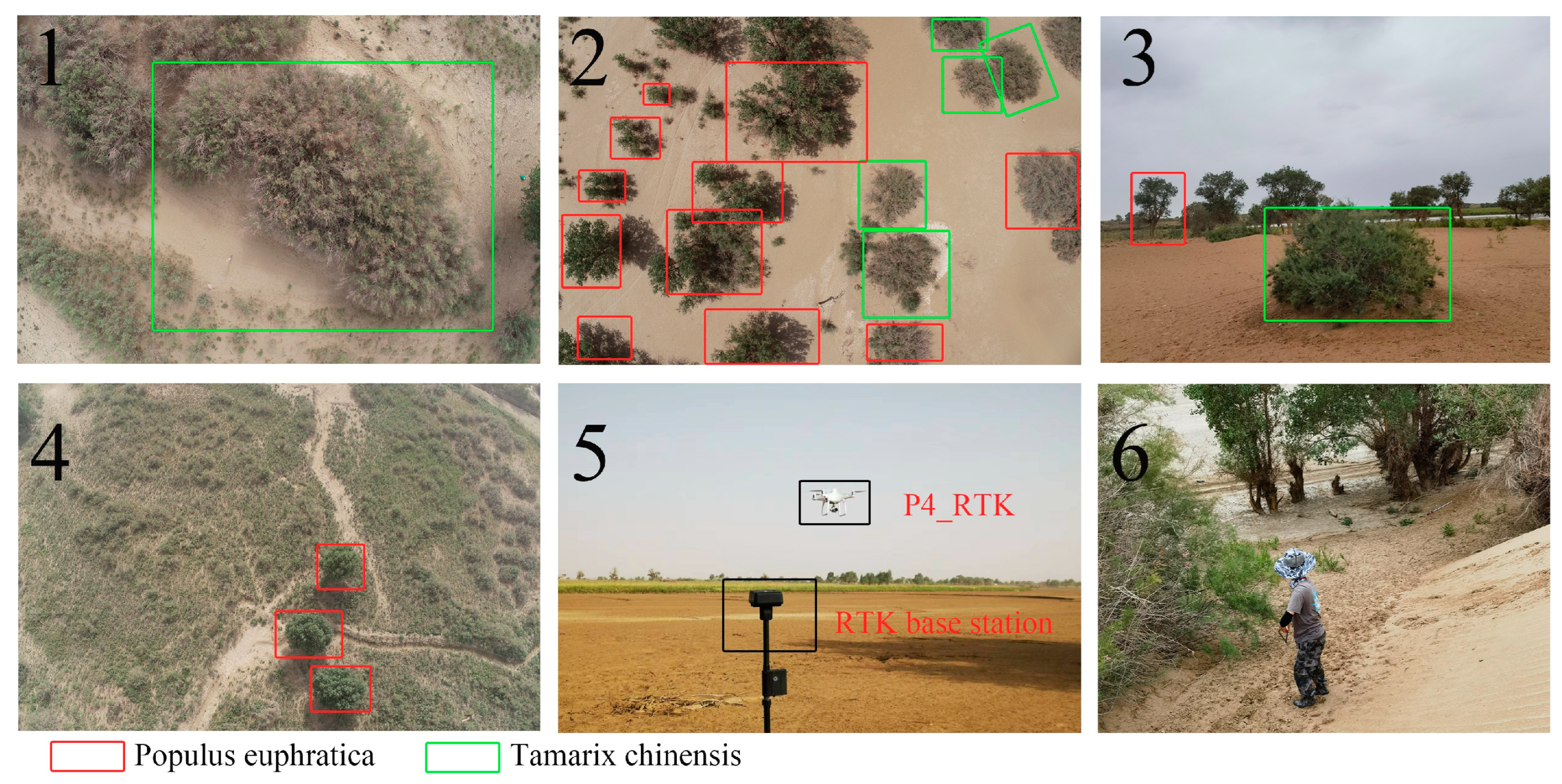
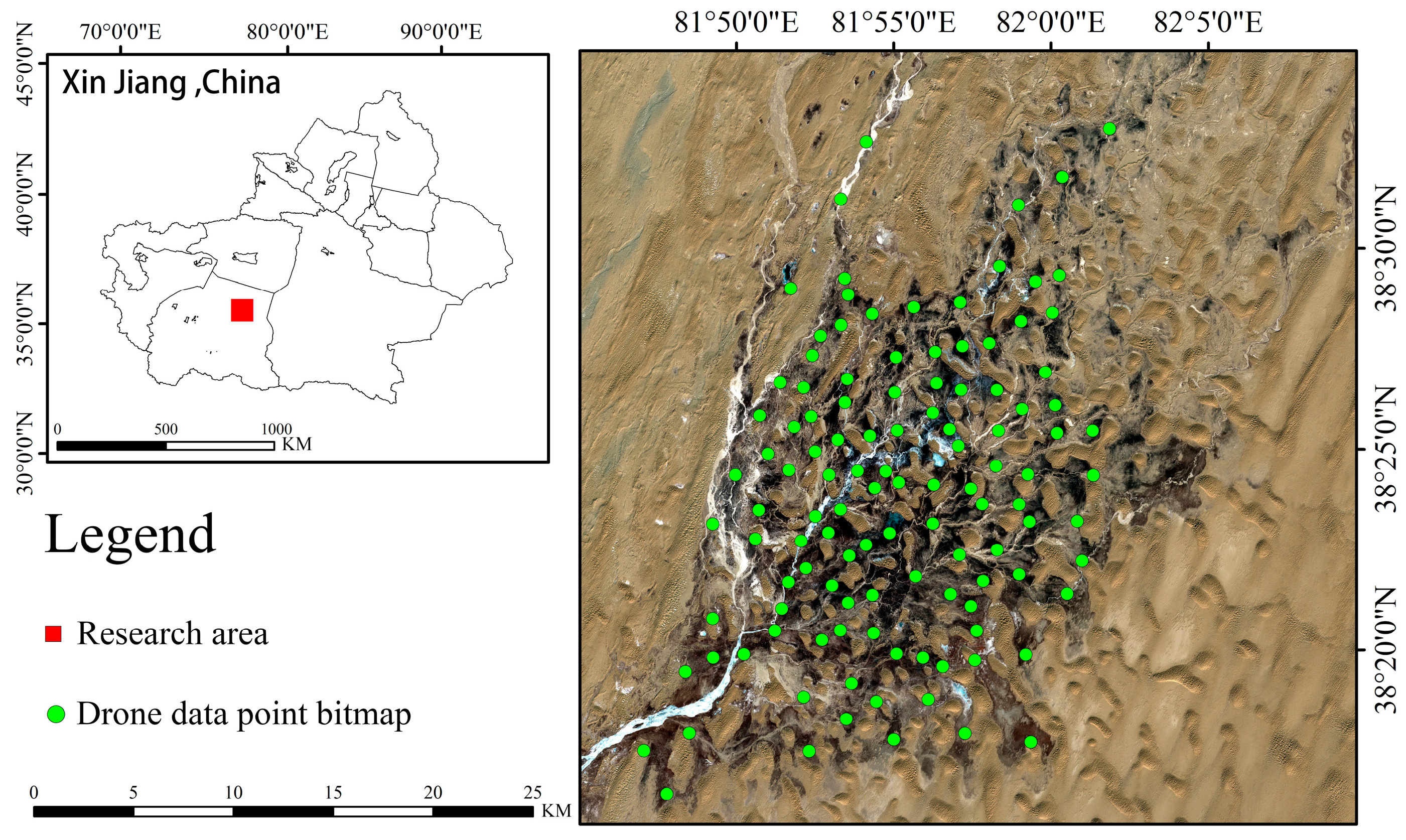
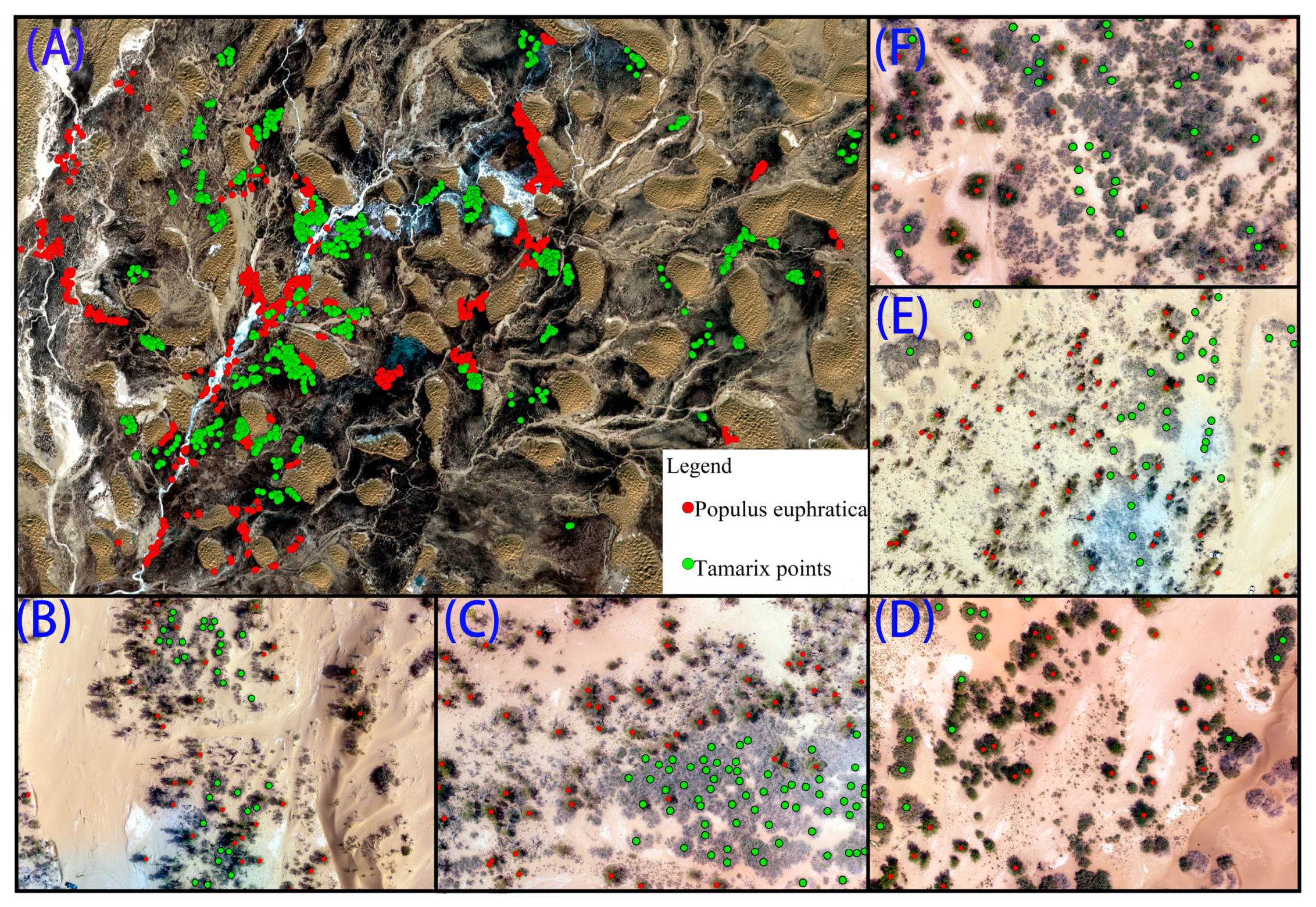


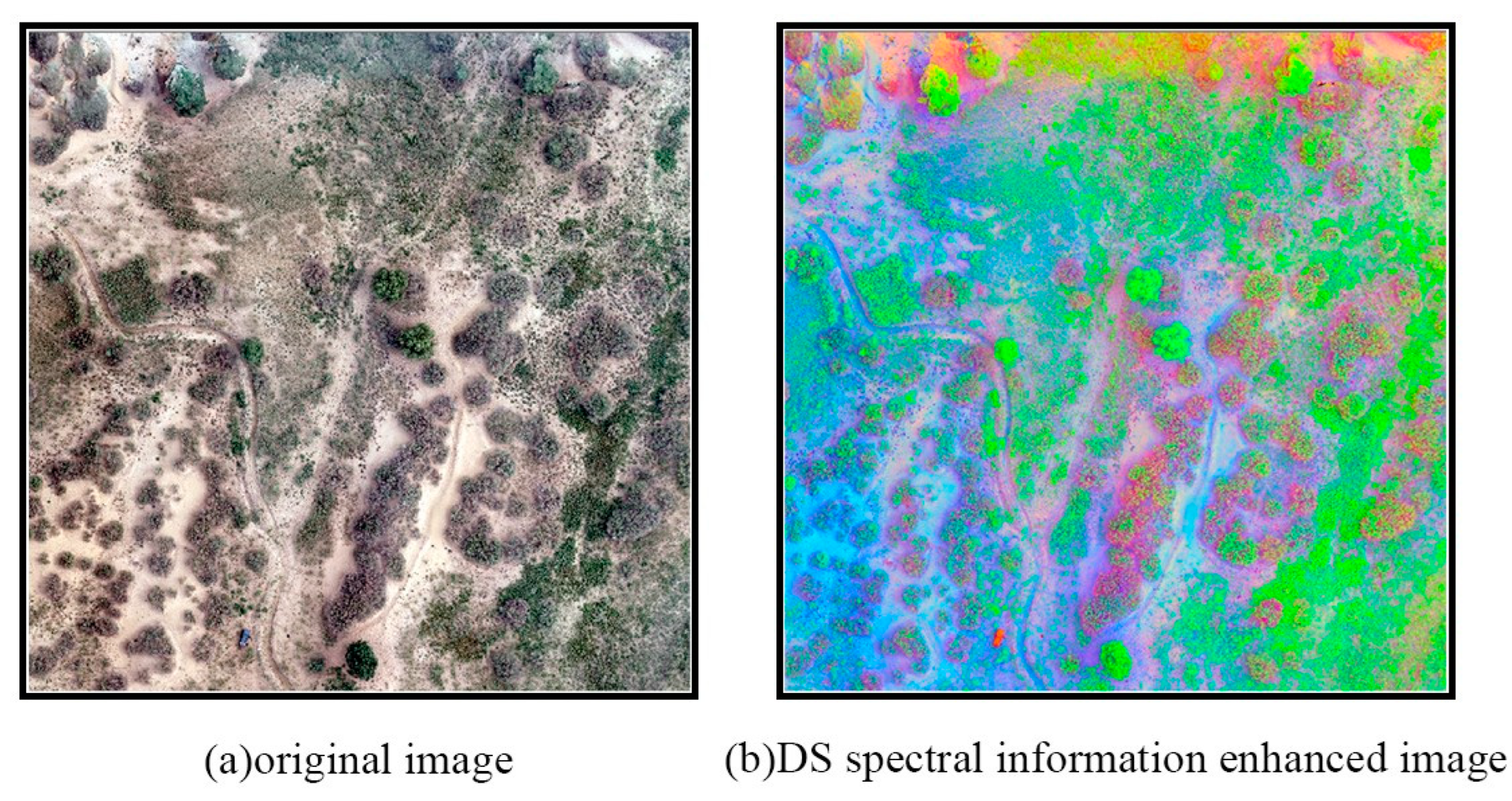
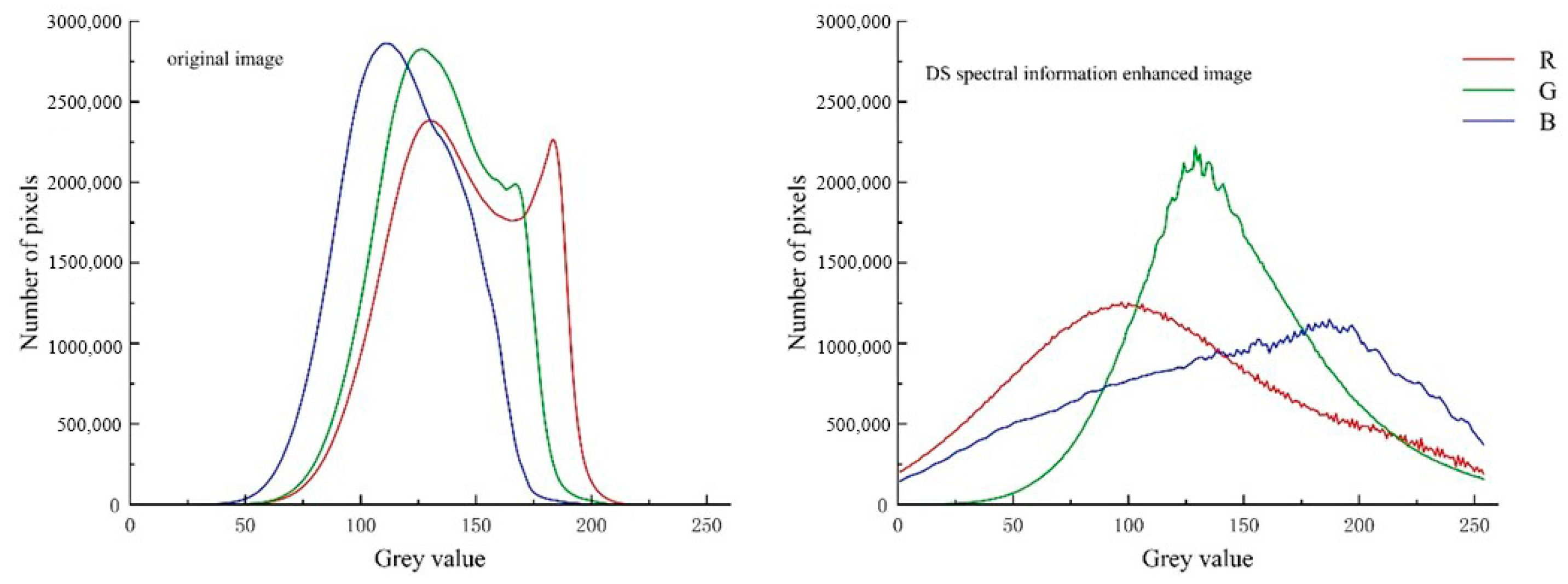
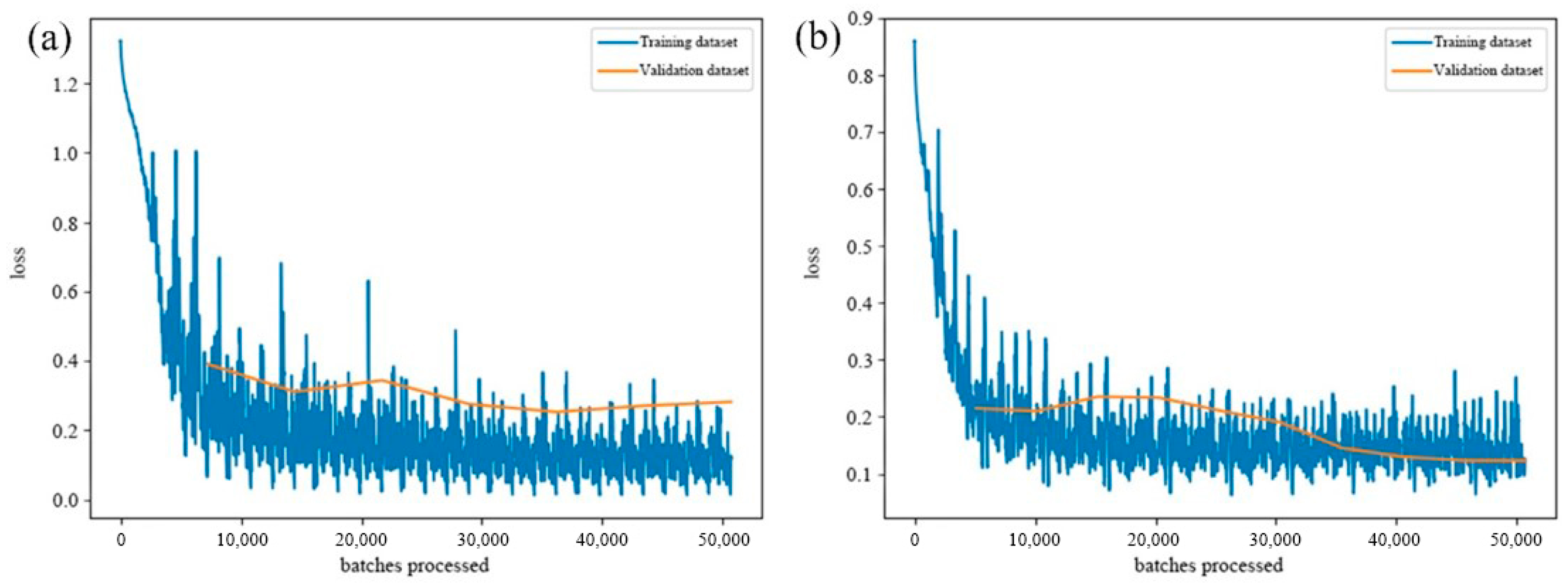
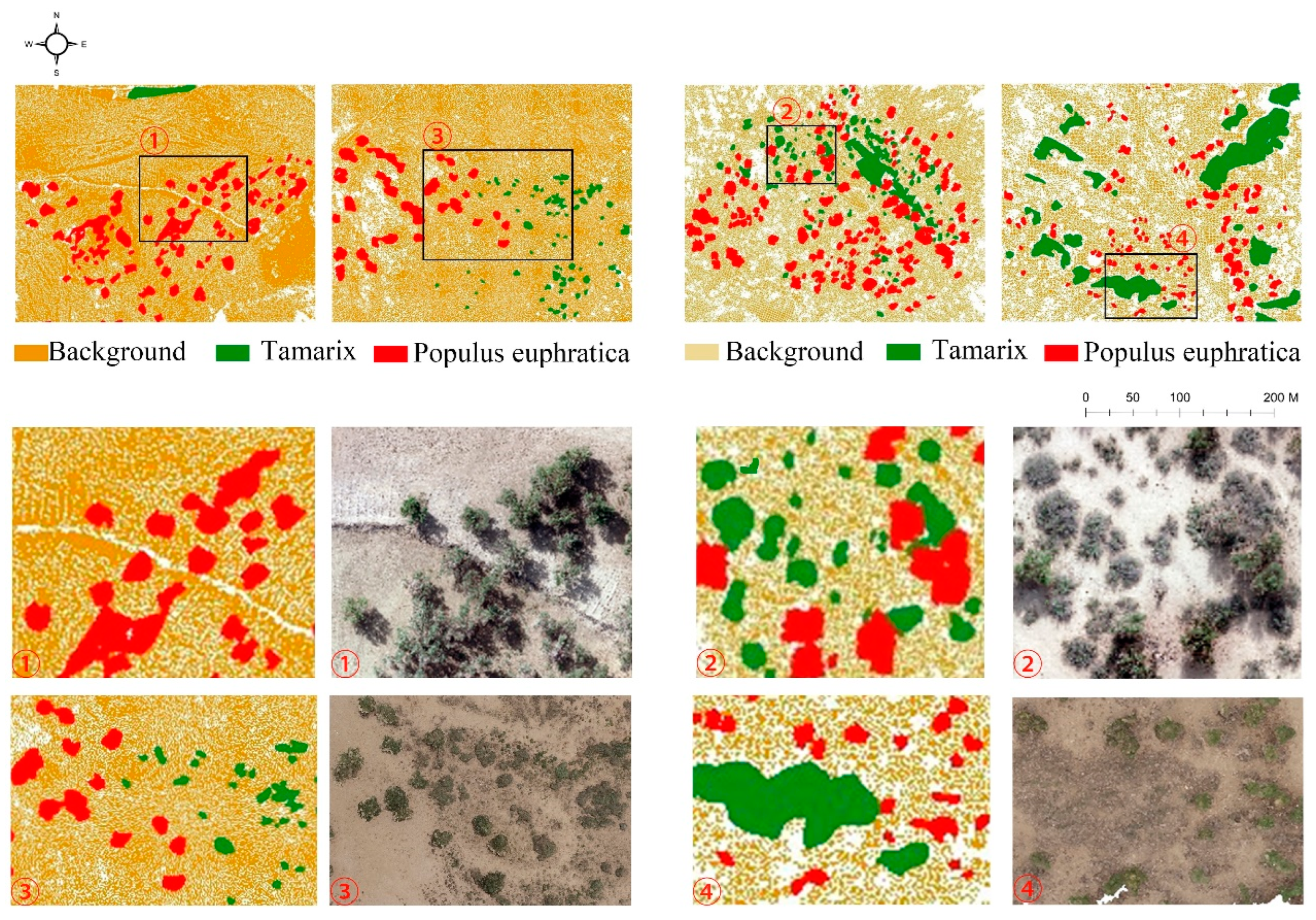

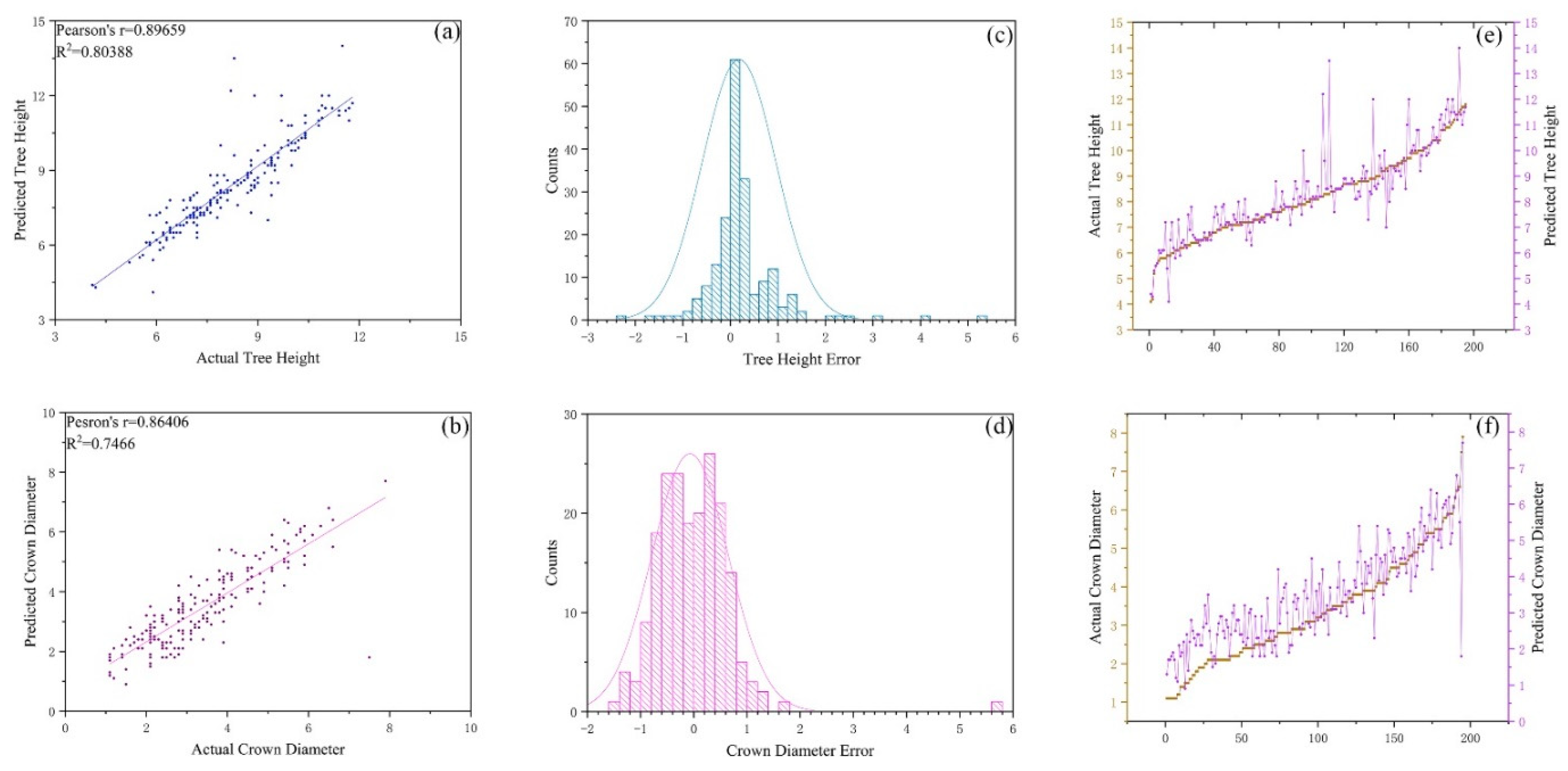
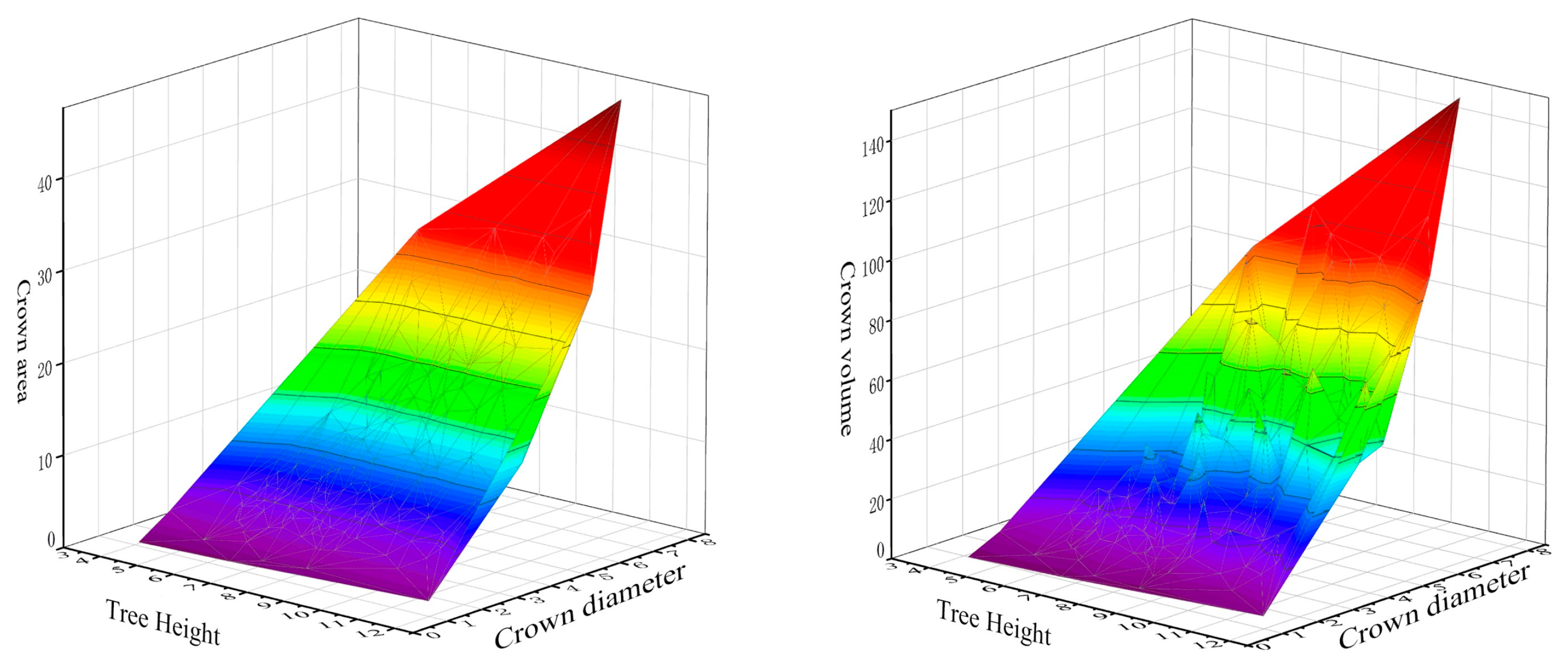
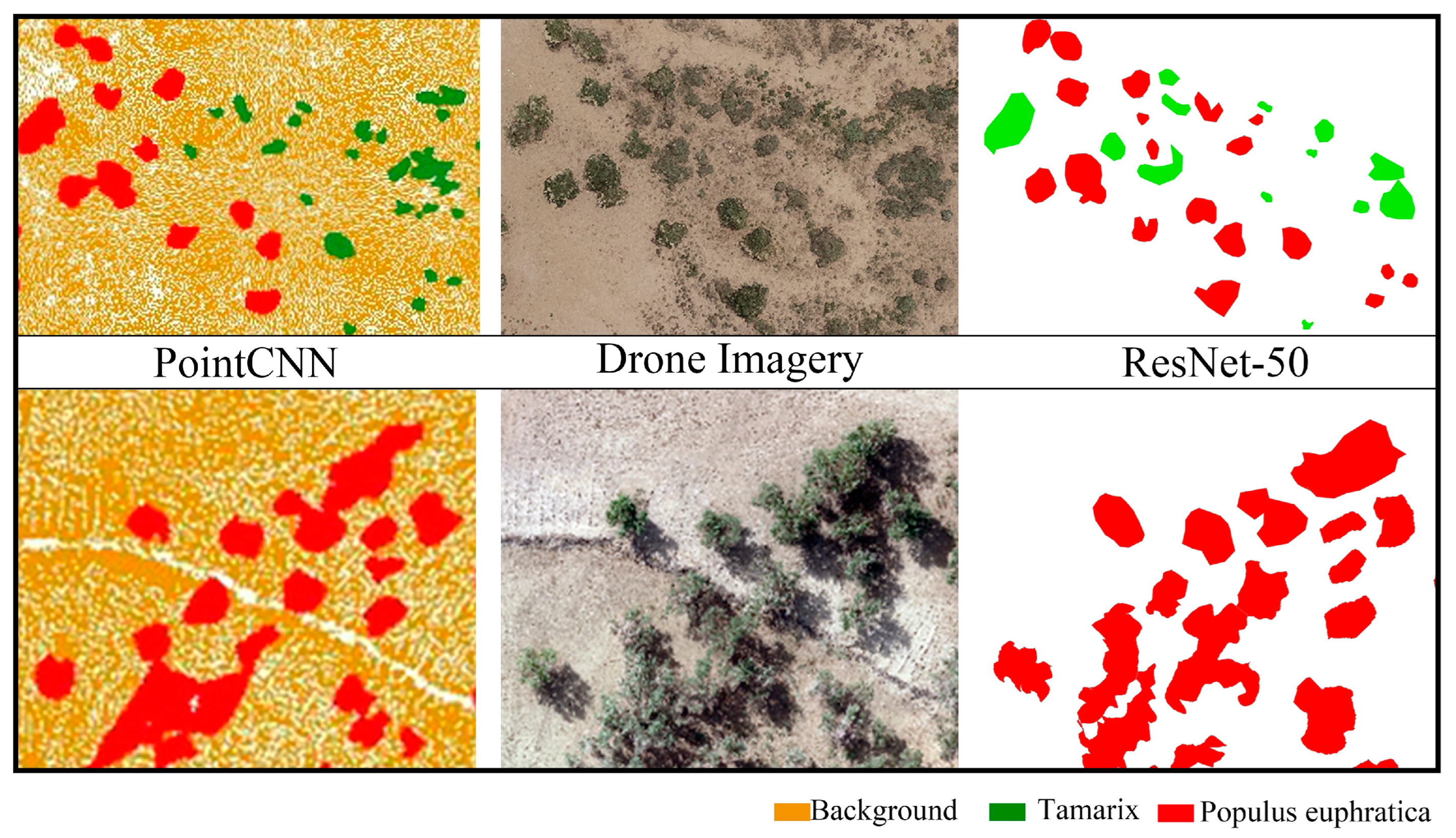
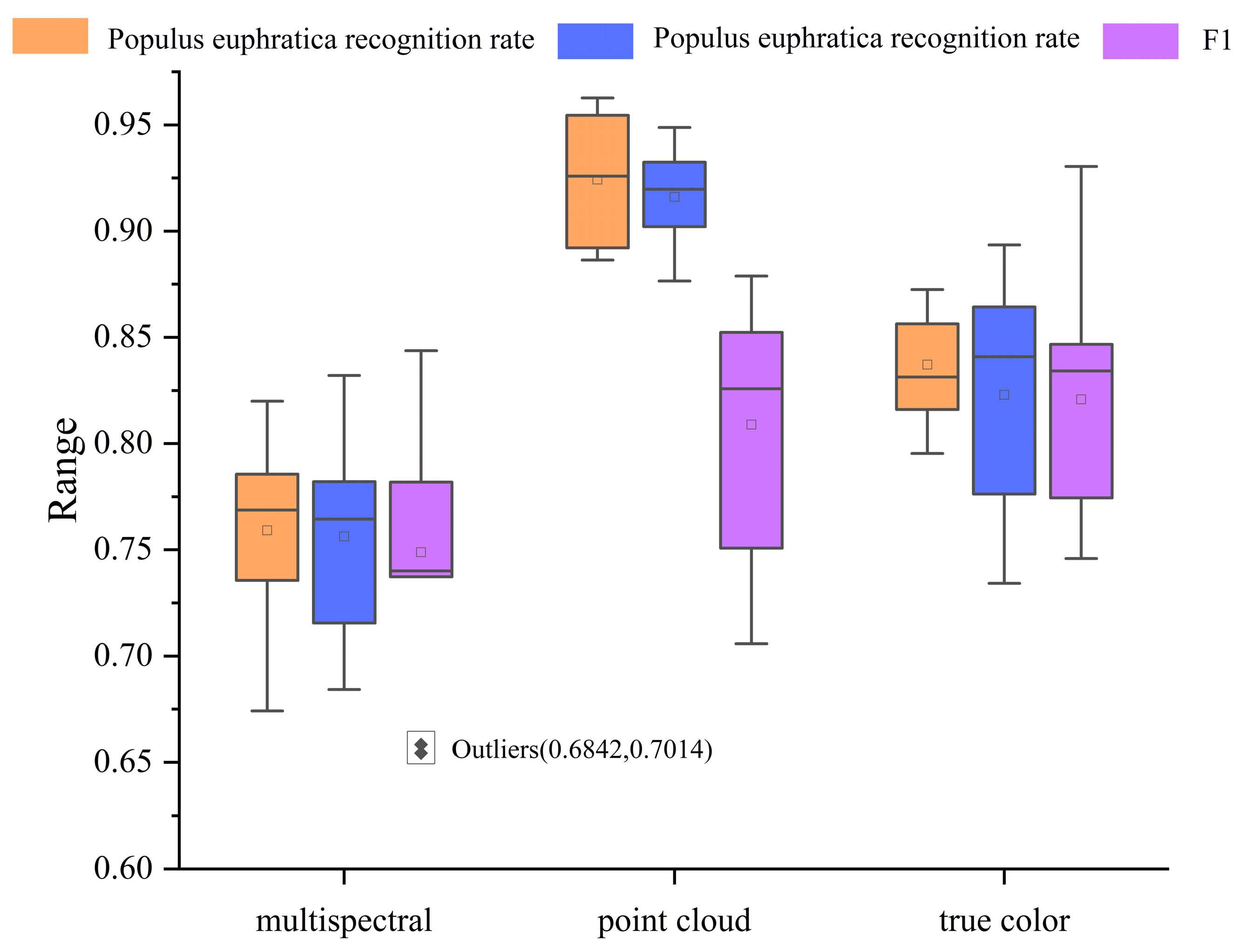
| Description | Specification | ||
|---|---|---|---|
| P4_Multispectral component | Aircraft | Take off weight | 1487 g |
| Maximum flight altitude | 6000 m | ||
| Flight time | 27 min | ||
| Operating frequency | 5.725 to 5.850 GHz | ||
| Footage | Visible-light imaging | Red, Green, and Blue (RGB) synthesis | |
| Multiband imaging | Blue (B) 450 ± 16 nm; Green (G) 560 ± 16 nm; Red (R) 650 ± 16 nm; Red edge (RE) 730 ± 16 nm; Near infrared (NIR) 840 ± 16 nm | ||
| P4_RTK | Aircraft | Take off weight | 1391 g |
| Maximum flight altitude | 6000 m | ||
| Flight time | 30 min | ||
| Operating frequency | 5.725 to 5.850 GHz | ||
| footage | Visible-light imaging | Red, Green, and Blue (RGB) synthesis |
| Parameter | Image | Validation Dataset | |||||||||
|---|---|---|---|---|---|---|---|---|---|---|---|
| 1 | 2 | 3 | 4 | 5 | 6 | 7 | 8 | 9 | 10 | ||
| Populus euphratica recognition rate/% | point cloud | 0.9236 | 0.8901 | 0.9627 | 0.9039 | 0.9545 | 0.9453 | 0.9561 | 0.8864 | 0.8921 | 0.9281 |
| true color | 0.8725 | 0.826 | 0.8311 | 0.8724 | 0.8315 | 0.7954 | 0.8154 | 0.8564 | 0.816 | 0.8545 | |
| multispectral | 0.7356 | 0.7632 | 0.6742 | 0.7856 | 0.7742 | 0.7885 | 0.82 | 0.7145 | 0.7532 | 0.7832 | |
| Tamarix chinensis recognition rate/% | point cloud | 0.9021 | 0.8765 | 0.9421 | 0.8842 | 0.9488 | 0.9324 | 0.9243 | 0.9075 | 0.9283 | 0.9152 |
| true color | 0.8362 | 0.8105 | 0.7342 | 0.7762 | 0.8779 | 0.8643 | 0.8456 | 0.8546 | 0.7363 | 0.8935 | |
| multispectral | 0.7156 | 0.8321 | 0.6842 | 0.7819 | 0.7937 | 0.7746 | 0.7432 | 0.7821 | 0.7544 | 0.7014 | |
| F1 | point cloud | 0.8789 | 0.8110 | 0.8436 | 0.7985 | 0.8406 | 0.7508 | 0.8523 | 0.7331 | 0.7058 | 0.8746 |
| true color | 0.8437 | 0.8263 | 0.79 | 0.8420 | 0.7593 | 0.9304 | 0.8467 | 0.8495 | 0.7744 | 0.7459 | |
| multispectral | 0.7385 | 0.7819 | 0.8331 | 0.8437 | 0.7615 | 0.6584 | 0.7416 | 0.7373 | 0.6543 | 0.73855 | |
Disclaimer/Publisher’s Note: The statements, opinions and data contained in all publications are solely those of the individual author(s) and contributor(s) and not of MDPI and/or the editor(s). MDPI and/or the editor(s) disclaim responsibility for any injury to people or property resulting from any ideas, methods, instructions or products referred to in the content. |
© 2023 by the authors. Licensee MDPI, Basel, Switzerland. This article is an open access article distributed under the terms and conditions of the Creative Commons Attribution (CC BY) license (https://creativecommons.org/licenses/by/4.0/).
Share and Cite
Li, D.; Shi, Q.; Peng, L.; Wan, Y. Plant Population Classification Based on PointCNN in the Daliyabuyi Oasis, China. Forests 2023, 14, 1943. https://doi.org/10.3390/f14101943
Li D, Shi Q, Peng L, Wan Y. Plant Population Classification Based on PointCNN in the Daliyabuyi Oasis, China. Forests. 2023; 14(10):1943. https://doi.org/10.3390/f14101943
Chicago/Turabian StyleLi, Dinghao, Qingdong Shi, Lei Peng, and Yanbo Wan. 2023. "Plant Population Classification Based on PointCNN in the Daliyabuyi Oasis, China" Forests 14, no. 10: 1943. https://doi.org/10.3390/f14101943
APA StyleLi, D., Shi, Q., Peng, L., & Wan, Y. (2023). Plant Population Classification Based on PointCNN in the Daliyabuyi Oasis, China. Forests, 14(10), 1943. https://doi.org/10.3390/f14101943




